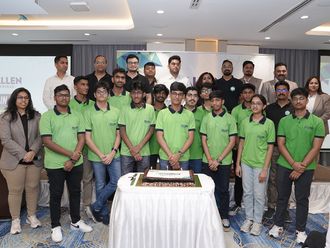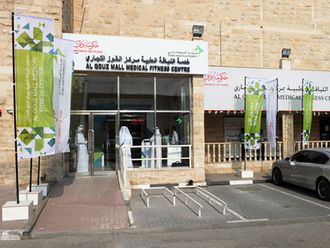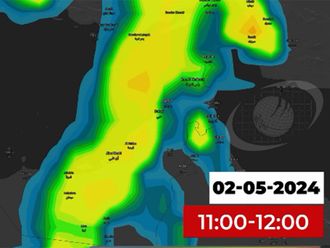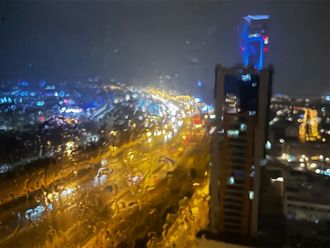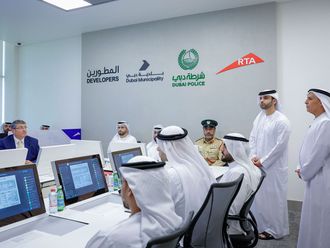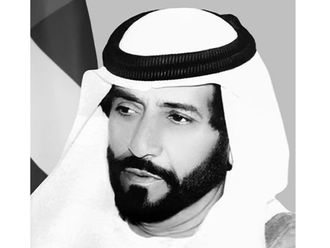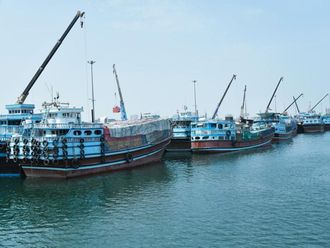The entire interior of the region comprises mountains, with one graded track that stretches from Daba to Khasab ©Gulf News |
Khasab. The idyllic Musandam peninsula is the northernmost part of Oman, near the Straits of Hormuz. Bordering the UAE, it is easily accessible from Dubai by road or air.
As you arrive at Musandam, the scenery is spectacular, with high barren mountains plunging dramatically into the seas, their tops touching the skies.
The entire interior of the region comprises mountains, with one graded track that stretches from Daba to Khasab snaking through narrow gorges, around hairpin bends and down into wadi beds. The coastline has fingers of fragmented rocks reaching claw-like out into the sea, creating long khawrs (fjords) and inlets. Small settlements nestle on what little flat land there is along the tortuous shoreline, most of them only accessible by sea. It is only in recent years that the completion of the graded road through the interior and a surfaced highway skirting the west coast of the peninsula have made motorised travel possible.
The fjords are dotted with islands and the crystal clear water shimmers in the sun. The fantastic scenery has made the province well known as the Norway of Arabia.
The coastal zone, with its many offshore islands and inlets, abounds with wildlife, including breeding seabirds, dolphins, whales and numerous species of fish — a diver's and nature lover's paradise. The glossy water reflects mirror images of the mountains.
The roughly 150-kilometre four-hour drive from Dubai to Khasab via Ras Al Khaimah has resulted in 70 per cent of tourists coming from the UAE. Mainly residents come here to enjoy the weekends and holidays.
Musandam has many important archaeological sites like pre-Islamic tombs and rock art, some of which date back five millennia. The best way to experience the full splendour is by sea, and no visit to the region will be complete without a boat trip.
A dhow trip into the fjords offers an insight into where dolphins play, and guarantees an ambience of peace and tranquility.
The striking juxtaposition of long fjords and barren mountains are epitomised by Khawr Sham, a spectacular, sheltered two kilometre-long fjord. High cliffs that drop precipitously into the sea flank its calm and clear water.
Qanaha, one of the number of small villages along the fjord, bends into the cliffs, its stone houses seemingly part of the cliffs themselves. Maqlab, a community of around 10 houses, sits high on the mountainside overlooking the fjord.
Discover Bedouin villages or the famous Jazirat Al Maqlab, Telegraph Island, where some British technicians laid a telegraph cable from India to Basra, Iraq, in 1864. The project took 10 years to complete. The island's isolated location, around a hidden bend in a fjord, calls to mind the expression "going around the bend".
The submarine cable carried the first telegraphic message between Karachi and London. The old cable can still be seen on the seabed, and snorkel around the island.
You can also enjoy snorkelling and swimming at Seebi Island, which is near the end of the fjord. Butterflies flutter over the decks of boats at anchor. Many species of sea birds nest in the cliffs and dolphins congregate in the sheltered waters, leaping and playing in the wake of cruising boats. An ideal place for scuba diving. Underneath the water, you can see colourful corals and sea fishes, which swim along with you. The sea is quiet here. The best time to visit the region is from December to March.
A picturesque fort known as Khasab Fort, on the inner cove of Khasab Bay, overlooks the harbour and represents its eastern line of defence. Contained within its low, crenellated walls is a massive central tower that predates the fort itself and preceded the arrival of Portuguese in the 16th century. A Portuguese garrison occupied the site until 1644, when Imam Nasir bin Murshid Al-Ya'rubi united Oman's land forces and, supported by strengthened naval forces, regained control of the coast. The fort was renovated by his successor, Said bin Sultan Al-Ya'rubi in the latter half of 17th century, and was used as a strategic outpost by the rulers of the Al Bu Said. The fort is open all year round to visitors from Saturday through Thursday. Traditional boats and houses are on display in the castle courtyard. It also showcases the heritage and culture of the region. The fort was renovated from 1989-92. This fort was the residence of the Wali and Governor of Musandam.
In Ar Rawadh, you can find an old Islamic graveyard. The graves range from those of the smallest children to imposing adult ones. The headstones have interesting engravings including horsemen, palm trees and jewellery. Looking across the wadi bed from the graveyard, over to the right in the distance, there are a number of pre-Islamic cairn tombs. Turning right along the track to Rawadh Bowl there is further evidence of early settlement.
After the winter rains, it is as green as an English meadow and fragrant with the scents of wildflowers and herbs. Gazing goats are almost lost in the tall grass. Old acacia trees create a shaded woodland where camels — not common in Musandam because of the rocky conditions — wander at leisure. There are stone dwellings and storehouses, granaries, livestock pens and walls surrounding the fields to trap water for irrigation.
Jebel Harim, the 'Mountain of Women', Musandam's highest mountain, at 2,087 metres, is speckled with fossils dating back several million years. It winds along a ridge with breathtaking views down into the wadis and foothills. Green fields are enclosed by stonewalls which protect the crops from livestock and trap each drop of precious water that runs off the impermeable rocky surface. On top of the mountain, you can see the golf-shaped radar station, under the control of military, not for trespassers. It is a safe place to stop and enjoy the stunning views overlooking the ravine.
The population of the peninsula is around 30,000.
The main source of income is from fishing and goat herding. The hard-earned catch is later exported to Dubai markets through trucks from Khasab Harbour. The region is building three harbours — for Iranians, fishermen and tourists. These will be completed in two years' time. From time to time a battil can still be glimpsed in the harbour, its long, graceful bow wrapped in goatskin and rows of cowrie shells and colourful ribbons decorating its high, elegant stern.
There are lots of villages on the mountaintops. You can still find stone houses and caves used by the Bedouins. Some are still used as winter accommodation, demonstrating the hardiness of the people. Ancient stone dwellings provide a glimpse of the life of the people of the mountains. Pre-historic cave paintings on the rocks at Tawi are more than 2,000 years old.
The magnificent Khawr Najd, where the Indian Ocean meets the mountains, is


